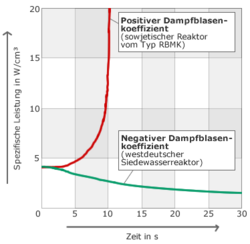Bubble coefficient
The vapor bubble coefficient (also known as the coolant loss coefficient or void coefficient ) is a measure of the change in the reactivity of a nuclear reactor when vapor bubbles form in the coolant, in the moderator or in the liquid fuel (in a dual-fluid reactor ). A change in reactivity that is not compensated for, in turn, results in changes in the thermal output of the reactor. Therefore, the void coefficient is important for the safety of the reactor.
The term vapor bubble coefficient is mainly used for boiling water reactors , where the purpose of the operation is to generate steam in the reactor core. In all other reactor types, the formation of bubbles or cavities is a deviation from normal operation, and this is referred to as the coolant loss or void coefficient . Physically it is the same size.
The void coefficient is an example of a reactivity coefficient .
Explanation and definition
Most reactor types use water under pressure as the reactor coolant, while others use liquid metal or gas. As soon as the core temperature rises sufficiently, a liquid coolant begins to boil, which creates vapor bubbles, i.e. cavities in the coolant (this is the normal operating state for a boiling water reactor). Loss of the coolant can also lead to the formation of cavities ( loss of coolant accident ).
The liquid coolant usually also serves as a moderator and also inevitably acts as a neutron absorber to a certain extent. The gas bubbles, i.e. the vaporous coolant, have much less effect than the liquid coolant due to their much lower density, which changes the neutron multiplication factor k (see criticality ). For a small change in the proportion of bubbles in the total coolant volume , the corresponding change in reactivity = ( k -1) / k is proportional to the percentage change in volume ; the constant of proportionality is the void coefficient
.
The vapor bubble coefficient of a reactor with a liquid moderator and / or coolant can, depending on the design, be positive in all operating states or negative in all operating states or change its sign depending on the operating state. In reactors whose core does not contain any liquids, there is naturally no bubble formation and no vapor bubble coefficient.
Typical numerical values of the vapor bubble coefficient for a boiling water reactor are e.g. B .:
−1.2 · 10 −3 /Vol.-% with 20% blister content,
−1.6 · 10 −3 /Vol.-% with 40% blisters.
Positive void coefficient
A positive vapor bubble coefficient means that the thermal performance of a reactor increases when gas bubbles form in the core or voids are created due to the loss of coolant. If the vapor bubble coefficient is large enough and the control system is not fast enough, positive feedback can result, so that the entire coolant evaporates in a very short time.
This case occurred due to operating errors in the Chernobyl reactor accident , in which a nuclear power plant reactor of the type RBMK with a positive vapor bubble coefficient got out of control. With this type, it is not the cooling water that serves as a moderator, but graphite blocks attached outside the pressure pipes . The heat output, which had become too high, led to increased evaporation of the water. Since water vapor has a much lower density than water, fewer thermal neutrons diffusing back from the graphite were absorbed on the way to the fuel, which means that the reactivity was increased. In connection with other special design features, this led to the immediate overcriticality of parts of the reactor core and thus to the catastrophe.
The coolant loss coefficient is also positive for the CANDU reactor type , but so small that the corresponding changes in performance can easily be managed by the reactor control.
Negative vapor bubble coefficient
A negative vapor bubble coefficient means that the thermal performance is normally reduced if voids form in the cooling water or moderator. However, it also means that the reactivity increases as the size of the voids decreases; this can e.g. B. occur in a boiling water reactor with a sudden increase in pressure, such as when steam lines are accidentally sealed off.
In "normal" light water reactors , the coolant also serves as a moderator. The reactors are designed to be slightly under-moderated , i.e. That is, a decrease in the amount of moderator decreases reactivity under all circumstances. Such reactors always negative void coefficient is sometimes referred to as inherently stable or inherently stable called.
This stability should not be confused with what is known as the “inherent safety” of the reactor. For example, even a negative vapor bubble coefficient does not change the fact that bubble-infiltrated water cools less effectively, and above all does not change the decay heat that can lead to core meltdown in the event of a major loss of coolant accident and failure of every emergency cooling. In the accident in March 1979 at the Three Mile Island nuclear power plant , a facility with a negative vapor bubble coefficient, a partial core meltdown occurred . In the nuclear power plant Fukushima I came in March 2011 to such an accident.
literature
- Dieter Emendörfer: Theory of the nuclear reactors . Mannheim 1993
Individual evidence
- ↑ a b Dieter Emendörfer: Theory of nuclear reactors . Mannheim 1993.
- ↑ Why do CANDU reactors have a "positive void coefficient"? (in English)





